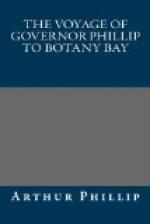Lieutenant Shortland now congratulated himself on having cleared this large tract of land, which he had the greatest reason to suppose united the whole way from the place at which he first fell in with it; as in sailing at a very moderate distance from the coast, he had made every effort in his power to find a passage to the northward. A place called by one of the French navigators, Port Surville, is probably a part of it, as well as Choiseul Bay, but the points seen and described by the French discoverers are very few; and for the knowledge of the form and bearings of the rest of the coast, throughout the whole extent of near three degrees of latitude, and full five of longitude, we are indebted entirely to the researches of our own countryman, as we are for the beautiful delineation of the whole coast, to the care and ingenuity of his son, Mr. John George Shortland. The only places in which Lieutenant Shortland suspected there might possibly be a passage which had escaped his observation, was between Cape Phillip and Cape Henslow, and again between the capes Marsh and Pitt. The ascertaining of these matters he leaves to other navigators, at the same time recommending the route he took as the safest and most expeditious passage within his knowledge from Port Jackson to China; Middleton Shoal, on the coast of New South Wales, being the only place of danger he had hitherto discovered. Should any objection be made to passing through a strait, where a more open sea can be obtained, he would recommend the much wider channel between Egmont Island and Simboo, and not by any means the whole circuit to the east of the New Hebrides. To the whole of this land, consisting of the two principal islands on each side of the straits, and the Treasury Isles between them, Lieutenant Shortland gave the name of New Georgia. There is, indeed, an island of Georgia, to the east of Staten Land, so named by Captain Cook in 1775: but between these, it seems to be a sufficient distinction to call the one the Isle of Georgia, and the other New Georgia. The land on the western side of Shortland’s Straits, continued to be very high, and extended as far as the eye could reach; from these circumstances, and from the direction in which it trended, no doubt was entertained of its joining that which was called by Captain Carteret, Lord Anson’s Isle. With respect to the charts here given of these discoveries, Lieutenant Shortland, though he cannot, from the distance at which they were taken, presume to vouch for the laying down of every single point, as if the coast had undergone a regular survey, undertakes to promise, that they are sufficiently accurate for the direction of any future navigators; as he had, in the course of his progress along it, many opportunities of taking lunar observations.
9 August 1788




